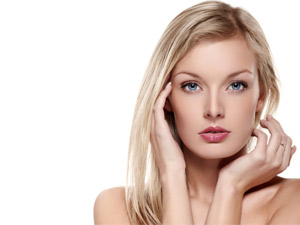Eggs, yogurt and honey are, at first glance, all components of a tasty breakfast — but they also happen to be Hair Care Treatment ingredients, and affordable, all-natural ones at that. And they're not the only ones. Did you know, for instance, that the oils in avocados more closely resemble our own skin's oils than any product in the beauty aisle does? Or that the mild acidity in lemon is an effective — and gentler — alternative to chemical-laden products? Next time your locks need a lift, save money by using one of these kitchen fixes.
For all hair types
"The [raw] egg is really the best of all worlds," says Janice Cox, author of "Natural Beauty at Home". The yolk, rich in fats and proteins, is naturally moisturizing, while the white that contains bacteria-eating enzymes, removes unwanted oils, she explains.
To use: For normal hair, use the entire egg to condition hair; use egg whites only to treat oily hair; use egg yolks only to moisturize dry, brittle hair, Cox says. Use 1/2 cup of whichever egg mixture is appropriate for you and apply to clean, damp hair. If there isn’t enough egg to coat scalp and hair, use more as needed. Leave on for 20 minutes, rinse with cool water (to prevent egg from "cooking") and shampoo hair. Whole egg and yolks-only treatments can be applied once a month; whites-only treatment can be applied every two weeks.
For Dull Hair care Problems
Styling products (as well as air pollution) can leave a film that both saps moisture and dulls shine — but dairy products like sour cream and plain yogurt can help reverse this damage. "Lactic acid gently strips away dirt while the milk fat moisturizes," says Lisa Belkin, author of "The Cosmetics Cookbook".
To Use: Massage 1/2 cup sour cream or plain yogurt into damp hair and let sit for 20 minutes. Rinse with warm water, followed by cool water, then shampoo hair as you normally would. Treatment can be applied every other week.
For itchy scalp
To fight flakes — brought on by poor diet, stress and climate, among other factors — try a lemon juice and olive oil mixture in your hair. "The acidity in lemon juice helps rid your scalp of any loose, dry flakes of skin, while the olive oil moisturizes the [newly exposed] skin on your head," says Cox.
To Use: Mix 2 tablespoons fresh lemon juice, 2 tablespoons olive oil and 2 tablespoons water, and massage into damp scalp. Let mixture sit for 20 minutes, then rinse and shampoo hair. Treatment can be applied every other week.
For limp or fine hair
To add body to hair, reach for an unlikely beauty beverage: beer! The fermented drink contains generous supplies of yeast, which works to plump tired tresses, explains Cox.
To use: Mix 1/2 cup flat beer (pour beer into a container and let it sit out for a couple of hours to deplete carbonation) with 1 teaspoon light oil (sunflower or canola) and a raw egg. Apply to clean, damp hair, let sit for 15 minutes, then rinse with cool water. Or add flat beer only to a spray bottle and spritz onto dry hair. "When the liquid evaporates, the remaining protein residue (from the wheat, malt or hops) continues to strengthen and structure hair," says Belkin. Treatments can be applied every other week.
For dry or sun-damaged hair
Whatever your hair-dehydrating demon — hard water, sun overexposure, your trusty flat iron — nature's sweetener can help. "Honey is a natural humectant, which means it attracts and locks in moisture," says Cox.
To use: Massage approximately 1/2 cup honey into clean, damp hair, let sit for 20 minutes, then rinse with warm water. You can also add 1 to 2 tablespoons olive oil to loosen the honey for easier application. For extremely sun-damaged hair, trying mixing honey with 1 to 2 tablespoons of a protein-rich ingredient, like avocado or egg yolk, which will help replenish the keratin protein bonds that UV rays attack. Treatment can be applied once a month.
For oily or greasy hair
"Used properly, [cornmeal or cornstarch] is an inexpensive way to remove oil and grease," says Belkin.
To use: Pour 1 tablespoon cornmeal or cornstarch into an empty salt or pepper shaker and sprinkle onto dry hair and scalp until you’ve used it all. After 10 minutes, use a paddle hairbrush to completely brush it out. Treatment can be applied every other day.
For frizzy hair
Home beauty experts swear by avocado — and not just to repair damaged hair. Its oils (which are light and moist like our own natural skin secretions) and proteins boast the best combination of nutrients for smoothing and weighing down unruly hair, explains Cox.
To use: Mash up half an avocado and massage into clean, damp hair. Let sit for 15 minutes before rinsing with water. Amp up moisturizing power by combining mashed avocado with 1 to 2 tablespoons of a hydrating ingredient, like sour cream, egg yolks or mayonnaise. Treatment can be applied every two weeks.
For residue-ridden hair
"Nothing eats through product buildup like baking soda," Cox says. Sodium bicarbonate essentially breaks down anything acidic.
To Use: Mix 1 to 2 tablespoons baking soda with small amounts of water until a thick paste forms. Massage into damp hair and let sit for 15 minutes. Rinse with water, then shampoo hair. Treatment can be applied every two weeks.






















